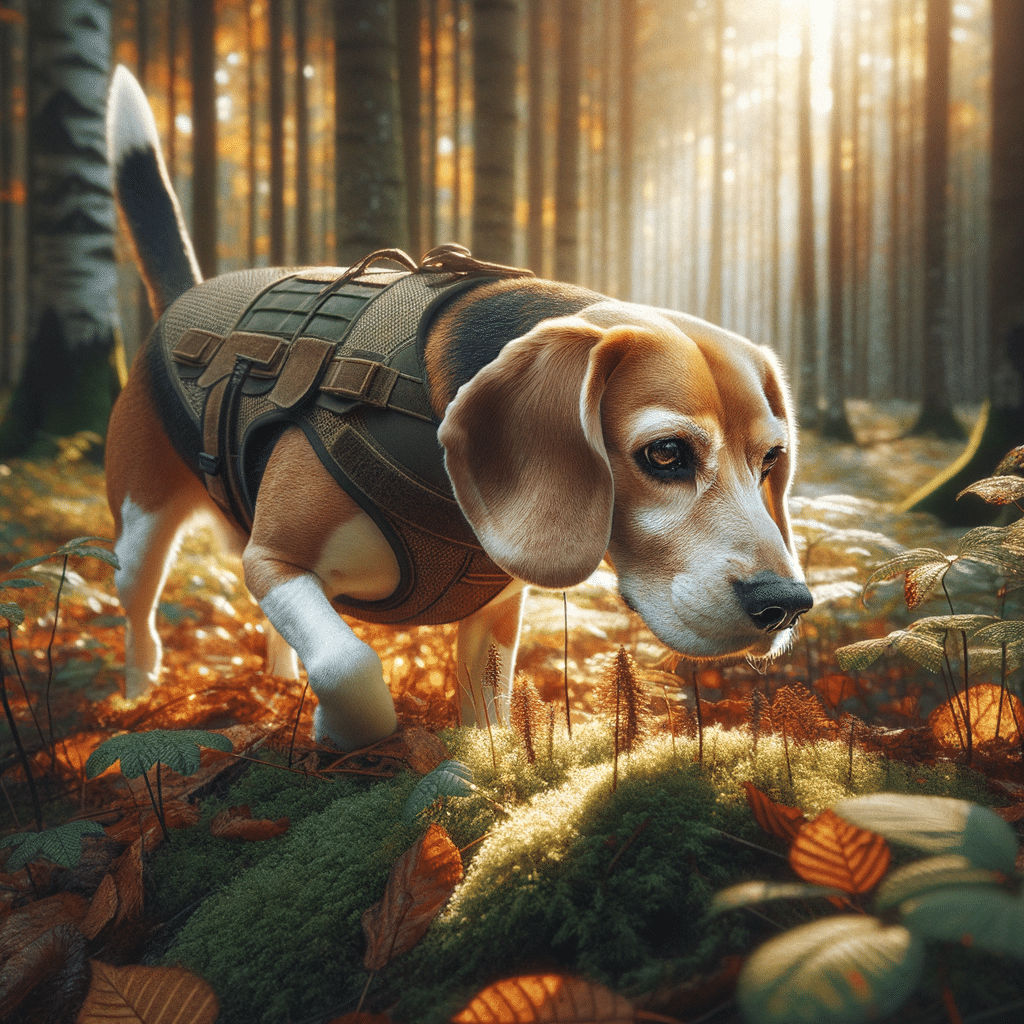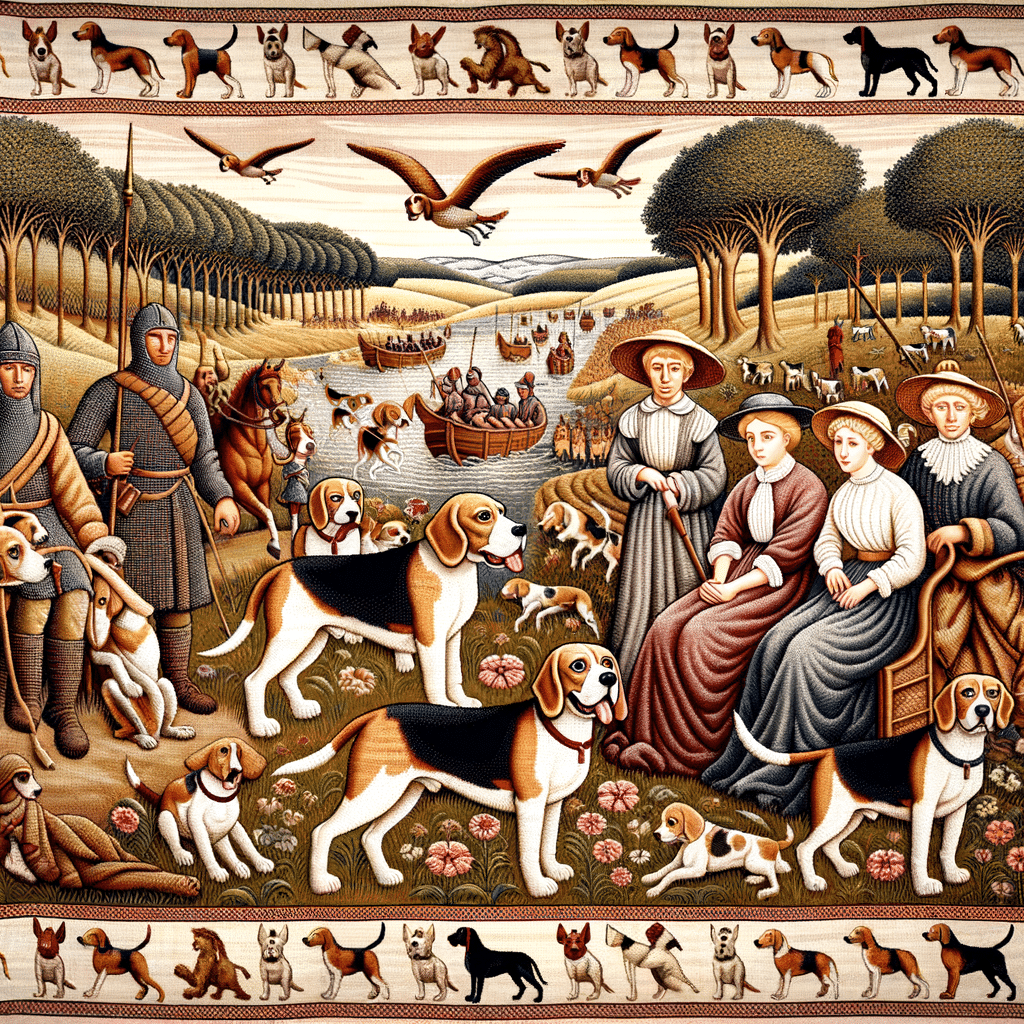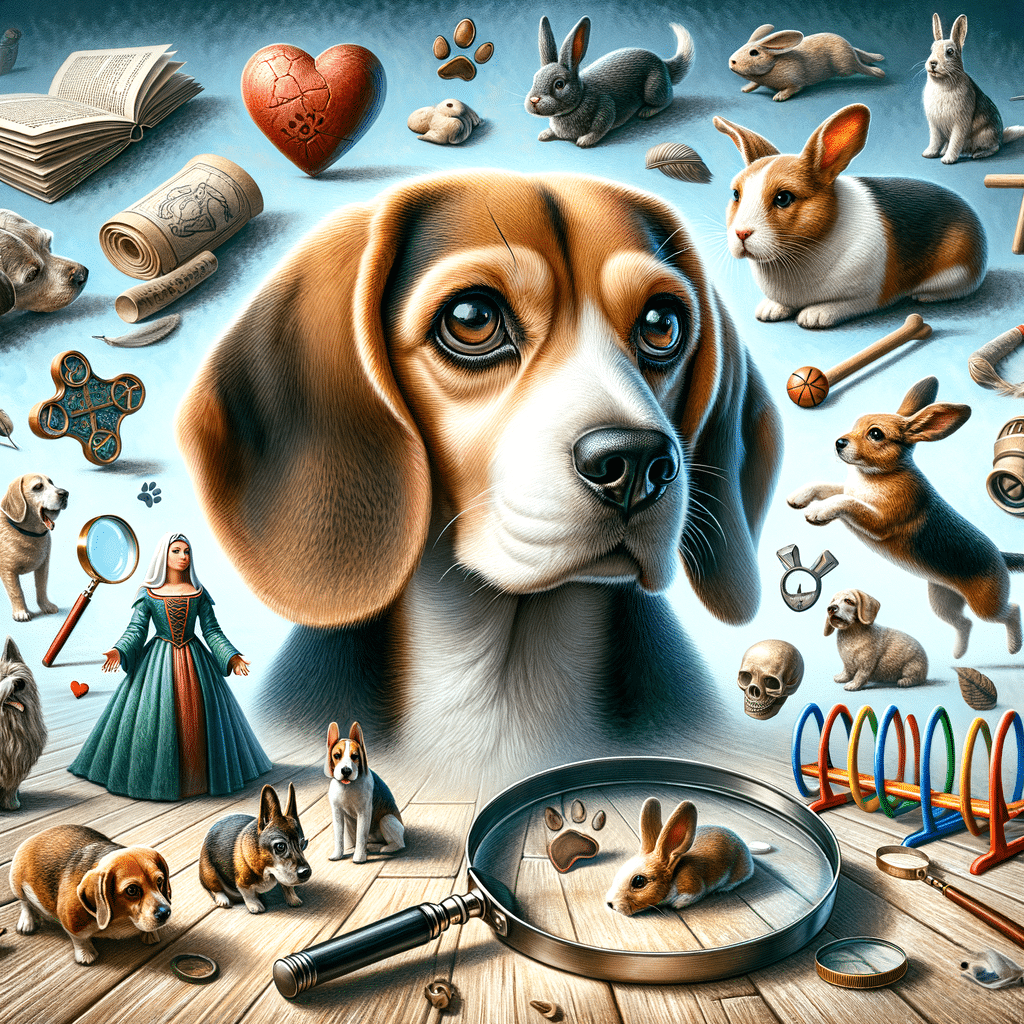The beagle is a breed with a history that ties back to ancient times, yet the version of the breed as we know it today was refined in England during the 1830s. Initially bred for hunting, they were prized for their keen sense of smell and stamina. This resulted from carefully breeding hounds with characteristics suited for tracking hares, an activity known as “beagling.”
In This Article
The breed’s ancestry includes contributions from the St. Hubert and Talbot hounds, which were brought to Great Britain by William the Conqueror and later crossed with Greyhounds to enhance their hunting capabilities.
Beagles are not just historical hunting dogs; their adaptability and friendly nature have made them cherished family pets. Recognized by the American Kennel Club in 1885, beagles have grown to become one of the most popular breeds in the United States.
Their medium size, expressive faces, and short coats make them appealing as pets and working dogs. Beyond the home, beagles excel in roles such as detection dogs due to their acute olfactory abilities, demonstrating their versatility and enduring relevance in various modern-day functions.
Highlights
- The beagle's origins trace back to ancient times, undergoing significant development in 19th century England.
- Esteemed for their scent-tracking ability, beagles have transitioned from hunters to beloved family pets and effective working dogs.
- Their consistent popularity is a testament to the beagle's adaptability, amiable disposition, and cultural significance as a breed.
Historical Roots of Beagles
The beagle’s lineage is intricately woven through the history of Great Britain. It stems from ancient hounds and evolved through selective breeding to become the generous breed known worldwide today.
Beagle Ancestry and Breeding
Beagles are believed to have originated from several ancient hound breeds. Foremost among them is the Talbot hound, a now-extinct hunting dog in England during the Middle Ages. Other significant ancestors include the Southern hound, the Northern hound, and the St. Hubert hound. It is thought that the skills of these hounds, particularly their scent-tracking ability, were combined over the centuries to breed an efficient hunting companion.
The dog breed’s development was largely influenced by Norman and French breeding traditions post the Norman Conquest, hinted at by the arrival of William the Conqueror in the 11th century. The integration with local hounds in Great Britain led to the development of the distinct line that would eventually become known as the beagle.
Development in England
In England, beagles gained prominence as hunting dogs, prized for their ability to track small game. The modern beagle’s characteristics were refined during the 18th century when hunting became popular among the English gentry and nobility. Individuals such as Reverend Phillip Honeywood established breeding programs in the 1830s, significantly impacting the beagle’s standardization. In addition, contributions from Thomas Johnson, who selectively bred to refine the breed into an even-tempered and skilled hunter, further solidified the beagle’s characteristics.
During the 19th century, the Beagle Club, established in 1890, and the National Beagle Club, formed in 1888, played vital roles in the breed’s development. The American Kennel Club recognized the breed in 1885, marking its international presence and appeal, leading to today’s modern beagle.
Modern-Day Evolution
In modern times, beagles have transitioned from their traditional hunting roles to becoming a popular family pet. This shift has been partly due to breeders like General Richard Rowett in the United States, who helped establish the breed’s standards outside of Great Britain. Due to their sharp sense of smell, they have also been among the preferred breeds for various roles, including in law enforcement as detection dogs.
Selective breeding has emphasized traits such as a good temperament, size, and olfactory skills rather than purely hunting capabilities. Crossbreeding with hounds like the Harrier may have influenced factors like the beagle’s size and agility. At the same time, traces of the greyhound and foxhound have likely contributed to its endurance and speed.
Through the committed efforts of clubs and breeders, the beagle has maintained its place in history as an ancient Greek hound’s descendant and a distinct and beloved breed with a rich historical tapestry that continues to thrive in households worldwide.
Physical Characteristics and Temperament
Beagles are known for their distinct features and temperament, making them a favored dog breed for families and individuals. They boast a remarkable sense of smell and a temperament that reflects their breeding as pack dogs.
Breed Description
Beagles generally come in two standard sizes: one standing about 13 inches at the shoulder, and the second at around 15 inches. Floppy ears and a broad head complement their sturdy and compact frame. The coat is typically short, and while they can exhibit a range of colors, common combinations include black, red, lemon, and white. Beagles have large brown or hazel eyes, often giving them a cute and pleading expression.
Behavioral Traits
Behaviorally, beagles are characterized by their happy-go-lucky nature. They are often affectionate and loving with family. Their energy levels are high, necessitating regular exercise to stimulate them mentally and physically. Beagles were originally bred as scent hounds to track game, and this tracking instinct remains strong, alongside a superb sense of smell. As such, they make excellent detection dogs. Through their history as pack animals, beagles typically get along well with other dogs and enjoy companionship.
Beagles in Hunting and Detection
Beagles have a storied heritage as hunting dogs due to their sharp olfactory abilities and more modern roles in contraband detection.
Traditional Hunting Roles
With its acute sense of smell and stamina, the beagle excelled historically in hunting roles, often working in packs. Originally bred to track hares and rabbits, the beagle was a favored choice for hare hunts, commonly called beagling. Their smaller size allowed these scent hounds to pursue game in areas larger hounds could not easily access. Beagle packs were compelling and provided a social aspect to hunting, making them valued hunting companions.
Modern Detection Work
As time progressed, beagles adapted their sniffing prowess to more contemporary applications. Recognized by the American Kennel Club (AKC) for their keen olfactory senses, beagles are now prominent as detection dogs in various fields. Their non-threatening size and insight make them ideal for detecting prohibited agricultural imports and foodstuffs in quarantine. Beyond traditional hunting, beagles assist law enforcement and security agencies at borders and airports, safeguarding against the spread of pests and diseases by sniffing out contraband.
Cultural Impact and Popularity
The beagle’s presence in popular culture and its endearing qualities as a household pet have solidified its status as one of the most recognizable and cherished dog breeds.
Beagles in Popular Culture
Beagles have left an indelible mark on popular culture. The most iconic example is Snoopy from the Peanuts comic strip, which has earned beagles widespread recognition. This beloved character has appeared in countless television specials, cementing the beagle’s image as a funny and endearing breed. Moreover, the National Beagle Club of America reflects the breed’s prominence, celebrating its history and preserving its future.
The impact of beagles on television and other media forms extends beyond entertainment. Historically, various beagles, such as pocket and “glove beagles,” were portrayed as companions that fit in saddlebags or gloves, symbolizing their role as lapdogs. These descriptions speak to the breed’s social nature and versatility, from the hunting fields to being a family pet. Additionally, the “Beagle Brigade,” an assembly of scent-detecting beagles employed by U.S. Customs and Border Protection, has highlighted the breed’s remarkable olfactory skills and role in protecting agriculture.
Beagle as a Household Pet
Beagles have consistently ranked as a popular breed for families, attributable to their size, friendliness, and adaptability. They are known for their friendly demeanor, making them excellent companions. Socialization and training, essential components of beagle ownership, enhance their natural behavior as pack animals, conducive to their reputation as superb family pets.
Their popularity also extends to their melodic “singing,” a unique howl that can signify their presence and a part of who they are. While the breed’s tendency to vocalize requires considerate training, it is also seen as one of the charming characteristics that draw individuals to the breed. The beagle’s popularity among households continues to grow due to these traits and their aptitude for companionship.
Frequently Asked Questions
This section addresses some of the most common inquiries regarding beagles’ origins, development, and characteristics, providing clear and factual answers.
What is the historical origin of the beagle breed?
The Beagle is believed to have a rich history that traces back to ancient times. Similar to the modern beagle, small hound-type dogs used for hunting hares were mentioned as early as 400 BC in Greece and around 200 AD in Britain. The breed as we recognize it today was developed in England in the 1830s.
What were beagles initially bred to do?
Beagles were initially bred for hunting small animals such as hares, a pursuit known as beagling. Their keen sense of smell and stamina made them excellent for this task. They often worked in packs, followed on foot by hunters.
How have beagles evolved from their origins to become popular pets?
Since the American Kennel Club recognized them in 1885, beagles have transitioned from dedicated hunting dogs to beloved pets. Their friendly disposition, manageable size, and adaptability have contributed to their popularity in the household.
Can you provide information on the different varieties of beagle breeds?
Generally, two varieties of beagles are recognized based on size: those standing under 13 inches at the shoulder and those between 13 and 15 inches. Despite these variations, all beagles belong to the same breed, with no significant differences in type.
What are the distinct physical characteristics of a beagle?
Beagles are small to medium-sized dogs with sturdy builds and a squared-off snout. They exhibit a proud tail, large brown or hazel eyes, and long, hound-like ears. Their coat is typically short and comes in various hound colors, including black, brown, white, and tan combinations.
How do beagles compare to other hound breeds in terms of hunting capabilities?
Beagles are scent hounds with an exceptional sense of smell, surpassed only by the bloodhound within the hound group. Due to their strong olfactory abilities and persistent nature, they are skilled at tracking and hunting small game, making them comparable to other renowned hunting hounds.






